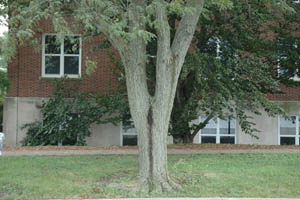Wetwood and Slime Flux | |
|---|---|
| August 13, 2007 | |
|
Bacterial wetwood and slime flux are conditions most apparent on species such as elms, poplars, and cottonwoods. There are many other susceptible species in our landscapes, as detailed in Report on Plant Disease (RPD), no. 656, “Bacterial Wetwood and Slime Flux of Landscape Trees,” available on the Web at http://www.ag.uiuc.edu/~vista/horticul.htm. Older trees are most often affected. Wetwood and slime flux refer to the wet appearance of the wood and the exudate (flux) that appears on the outside of the trunk. The two conditions comprise the disease complex. A wet or slimy exudate emerges from branch crotches, cracks in the bark, or points of injury on the infected tree. The liquid seeps down the outside of the tree, leaving a wet trail, as seen in the image of wetwood on honeylocust.  Fluxing is not continual, so sometimes a dry, white streak is seen. Bacteria are associated with wetwood and may be present in a tree for years before symptoms are apparent. Usually the problem is not a structural problem but just unsightly. Seeping has been apparent lately, probably related to air temperatures. The flux occurs when internal gas pressure from the bacteria increases, as is more likely to occur in warm weather. There is nothing that can or should be done to infected trees. Do not insert drain tubes into the wood because this may break the tree’s barrier to the affected tissue, allowing decay fungi to enter. Proper pruning that allows quick callousing of wounds can help prevent infection by bacteria that may cause wetwood. Fertilization may also help tree vitality. One concern with this disease is the presence of various insects in and around the flux. The insects are not a threat to the tree. The liquid is a food source to beetles, flies, butterflies, and moths. Scavanging insects may even lay eggs in the liquid. If wood rot occurs, insects may visit to feed on the rooting wood. |